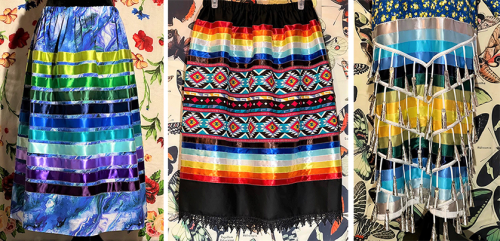
Ribbon skirts are more than just beautiful garments; they are vibrant expressions of Indigenous identity, resilience, and cultural pride. These flowing skirts, adorned with colorful ribbons, tell stories of tradition, resistance, and the enduring spirit of Indigenous communities.
Historical Roots and Evolution:
- Early Origins: The history of ribbon skirts can be traced back to pre-contact times. Indigenous women across North America crafted skirts using materials like animal hides and plant fibers. As trade with European settlers introduced new fabrics and adornments like ribbons, these elements were incorporated into traditional clothing.
- Ribbon Work as Artform: Ribbon work evolved into an intricate art form, with each community developing its own unique styles and patterns. Ribbons were often carefully chosen for their colors, symbolizing different elements of nature, spirituality, or personal stories.
- Cultural Suppression: During periods of colonization and forced assimilation, Indigenous cultural practices, including traditional dress, were suppressed. Ribbon skirts, along with other ceremonial garments, were banned or discouraged.
Modern Resurgence and Cultural Reclamation:
- 1970s Revival: The resurgence of Indigenous rights movements in the 1970s led to a renewed interest in traditional practices and dress. Ribbon skirts, once hidden away, began to reappear at cultural events and ceremonies.
- Symbol of Strength: Today, ribbon skirts are worn by Indigenous women of all ages as a symbol of strength, cultural pride, and connection to their ancestors. They are often seen at powwows, graduations, and other important life events.
National Ribbon Skirt Day (January 4th):
This annual event, established in 2021, honors the resilience of Indigenous women and girls. The day was inspired by the story of Isabella Kulak, a young girl who was shamed for wearing a ribbon skirt to school in 2020. The widespread support for Isabella ignited a movement celebrating ribbon skirts and their cultural significance.
Ribbon Skirts in Contemporary Fashion:
- High-Fashion Recognition: Indigenous designers are gaining recognition for their stunning ribbon skirt creations. Their work is featured in fashion shows and exhibitions, bringing Indigenous artistry to a global audience.
- Everyday Wear: While still holding ceremonial importance, ribbon skirts are also being embraced for everyday wear. Many Indigenous women incorporate them into their modern wardrobes, adding a touch of tradition to their personal style.
The Making of a Ribbon Skirt:
- Materials: Traditional ribbon skirts are often made from velvet, broadcloth, or other sturdy fabrics. Ribbons are meticulously hand-sewn onto the skirt in intricate patterns.
- Personalization: Ribbon skirts are often personalized with beadwork, embroidery, or other embellishments that reflect the wearer’s individual style and heritage.
- Sewing Circles: Many communities host ribbon skirt sewing circles, where women come together to create skirts, share stories, and pass down cultural knowledge.
The Importance of Ribbon Skirts:
- Cultural Preservation: Ribbon skirts are a tangible connection to Indigenous heritage and traditions. They represent the resilience of Indigenous communities and the ongoing efforts to preserve cultural practices.
- Empowerment: For Indigenous women, wearing a ribbon skirt can be a powerful act of self-expression and empowerment. It is a way to reclaim cultural identity and challenge stereotypes.
- Symbol of Unity: Ribbon skirts are a symbol of unity among Indigenous peoples across North America. They represent a shared history, a vibrant present, and a hopeful future.
Conclusion:
Ribbon skirts are more than just garments; they are living expressions of Indigenous culture, resilience, and artistry. From their historical roots to their modern resurgence, ribbon skirts continue to inspire, empower, and connect generations of Indigenous women.








